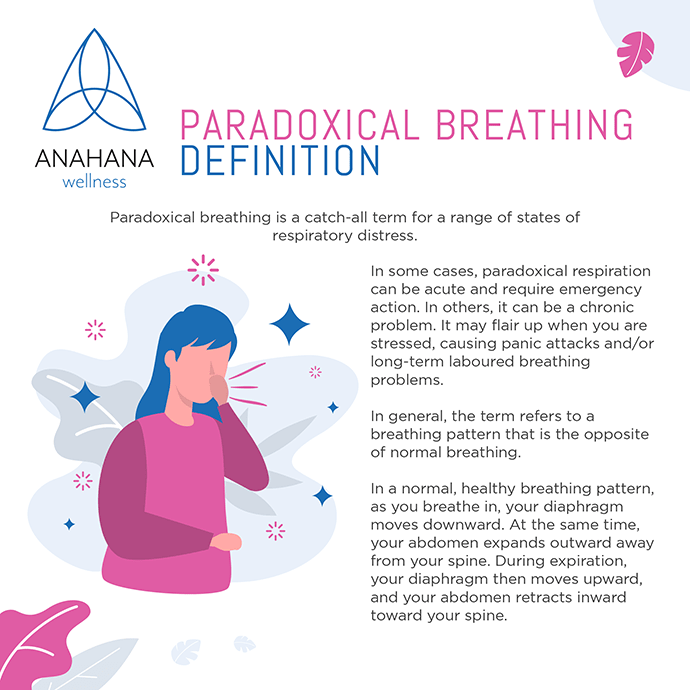Wim Hof Breathing Method
The Wim Hof Method is a three-step process developed by the legendary Iceman. Wim Hof has set numerous World Records about his ability to withstand...
In some cases, paradoxical respiration can be acute and require emergency action. In others, it can be a chronic problem.

Paradoxical breathing is a catch-all term for a range of states of respiratory distress.
In some cases, paradoxical respiration can be acute and require emergency action. In others, it can be a chronic problem. It may flair up when you are stressed, causing panic attacks and/or long-term labored breathing problems.
In general, the term refers to a breathing pattern that is the opposite of normal breathing.
In a normal, healthy breathing pattern, as you breathe in, your diaphragm moves downward. At the same time, your abdomen expands outward away from your spine. During expiration, your diaphragm then moves upward, and your abdomen retracts inward toward your spine.
This is also called diaphragmatic breathing, or belly breathing. The chest does not move.
When the opposite of diaphragmatic breathing occurs, this is called a paradoxical breathing pattern. It’s also known as double breathing.
In effect, your diaphragm moves upward and your abdomen retracts inward during exhale. Simultaneously, your diaphragm moves downward and your abdomen expands outward during inhale.
The following is a list of common signs and symptoms that someone is breathing paradoxically or in respiratory distress:

A number of factors can contribute to paradoxical breathing patterns.
Acute trauma to the chest is one cause that will instantly lead to intercostal contractions. These, in turn, can cause a paradoxical motion in breathing. This is also called stutter breathing or hitched breath.
In this case, emergency action must be taken to help the individual breathe.
However, chronic issues can contribute to abdominal paradox breathing as well:
When chronic stress from work or other issues becomes a problem, many sub-issues can lead to the paradoxical effect in breathing (sometimes referred to as double breathing or even hyperventilation).
Namely, the fight or flight response (elicited by chronic stress) can cause quicker, shallower breathing — in effect the type of breathing present with abdominal paradox.
In someone who becomes suddenly overwhelmed by fight or flight, for example, hyperventilation may occur. You might also see sudden deep breaths and frantic double breathing (seesaw breathing) in someone who is having a panic attack.
If you frequently have trouble catching your breath and simultaneously work a high-stress job or if you frequently experience traumatic situations, paradox breathing could become a regular problem for you.
Those who sit at desks all day may also find that their upper shoulders, and especially the scalene muscles in their neck, become tense and tight.
Excess use of these muscles when breathing can occur as a result. This can lead to a diaphragm that grows weak and works in a paradoxical way when breathing.
The effects then play off each other, with breathing becoming more and more labored and the scalene muscles causing more and more tension and pain.
Certain neurological issues, such as epilepsy or migraine headaches, can trigger the paradoxical response, hindering movement in the diaphragm and causing non-diaphragmatic breathing.
Paradoxical chest movement is more likely in those with lung-related health issues such as lung cancer, COPD, asthma, and others.
 Again, if someone is experiencing acute see-saw breathing as a result of trauma to the chest or another physical impairment that is hindering their ability to take in oxygen, emergency aid must be provided.
Again, if someone is experiencing acute see-saw breathing as a result of trauma to the chest or another physical impairment that is hindering their ability to take in oxygen, emergency aid must be provided.
Call emergency services, and administer an oxygen mask or necessary medication.
In the event of a panic attack or hyperventilation, when you or someone else is experiencing stutter breathing or a rapid paradoxical movement in your breathing, try these immediate actions, which can help calm you and restore normal breathing:
If you have been struggling with labored breathing for some time, often feel out of breath, or can’t quite seem to catch your breath sometimes, you may need to learn how to breathe better.
While this may sound silly (as everyone knows how to breathe to some extent!), learning how to breathe better is something that not many of us take the time to do — to our detriment. Read on for tips and sample exercises.
Here are some short sample breathing exercises to help you improve your breathing and combat the paradoxical effect:
Know what a proper deep breath looks like.
Go to a quiet place alone, without distractions. Shake out your muscles, and stand or sit with a good posturer. Lightly close your eyes. Exhale all of the air out of your lungs. Now, slowly inhale through your nose, taking care that:
Once you have deeply inhaled, begin to exhale out of your mouth, taking care that:
This is an example of how to breathe better with a proper breathing pattern.
Square breathing is a simple exercise to help calm shaky nerves, reduce stress, and elicit a relaxation response. Do it any time you feel overwhelmed or like you can’t catch your breath.
Here’s how to do it:
Repeat this four-step process for about one to two minutes.
The paradoxical chest movement occurs when, instead of moving downward on the inhale and upward on the exhale (as is the case in normal diaphragmatic breathing), the diaphragm moves upward on the inhale and downward on the exhale.
This opposite breathing pattern can cause shortness of breath, poor oxygen intake, physical distress, sleeping issues, and other short- and long-term complications.
If the problem is chronic and ongoing, relearning how to breathe and, specifically, learning how to do belly breathing, will be necessary to fix chronic paradoxical respiration.
In other situations where an acute injury or event has caused the paradoxical effect (for example, with flail chest), emergency measures, such as the administration of oxygen, must be taken.
Paradoxical breathing can be caused by an acute event such as blunt force trauma to the chest (from a car accident, for example). It can also be caused by chronic dysfunctional breathing or an event such as a panic attack.
Certainly, emotions and chronic stress and anxiety can contribute to the abdominal paradox. Sometimes, the cause of paradoxical movement in the breathing process is unknown.
In the tripod position, an individual places their hands on their knees, creating three-point support for the body. This position is often used to help someone who is having trouble with respiration or taking involuntary breathing gasps.
Tripoding engages the strap muscles in the neck for breathing, which allows more air in the lungs at a time.
Flail chest describes a serious injury in which three or more of a person’s ribs have been broken in more than one place and breathing has been hindered. The condition is often caused by a severe blunt force trauma to the chest.
Flail chest is an emergency situation because it often causes the individual to only be able to take in small amounts of oxygen. The broken area of the ribs is unable to help the lungs expand; it moves inward, not outward as it is supposed to.
It is fairly simple actually. The individual believed to be suffering from paradoxical breathing should lay down on a flat surface. In this position, it will be easier to render a diagnosis. All you will be doing is checking the movements while inhaling and exhaling. You will look at the chest cavity or the chest wall along with the belly. During inhale, the chest and belly should expand and while exhaling, the chest contracts along with the belly. If the order is reversed, and the belly and chest contract while inhaling, the individual is suffering from paradoxical breathing.
https://www.ncbi.nlm.nih.gov/pmc/articles/PMC5046973/
https://www.ncbi.nlm.nih.gov/pmc/articles/PMC6330798/
https://www.urmc.rochester.edu/encyclopedia/content.aspx?contenttypeid=22&contentid=flailchest


The Wim Hof Method is a three-step process developed by the legendary Iceman. Wim Hof has set numerous World Records about his ability to withstand...

Even though we are all breathing constantly, most people do not practice diaphragmatic breathing, which is how to breathe properly. The benefits from...

Buteyko is a method of breathing that decreases the respiration rate, that is reducing the number of breaths taken each minute to slow the breathing...